READING THE MARKERS
I propose the markers seen on some
images of the Voynich Manuscript contain information on how to read the images,
and that they are specifically placed for this purpose. It has long been
held that the images contain unreadable sentences, which are indicated by marks
such as this on where they begin/end. I alternatively suggest that these guide marks (which
from now on I refer to as “markers”) are in fact indicators that mark events,
directions, times and that some of the other fixtures in the images such as
people also do this.
I suggest greater (main) markers on an image
indicate main event and lesser marks indicate directions and lesser details. I
also suggest this varies for each page and what may be a lesser marker on one
page may be a greater marker on another, for example what appears to be a lesser
marker (b) in relation to other markers (a) on f67r appears to be a major type of
marker (c) on f57v and the lesser marker on f57v just a single line (d).
|
a |
b |
|
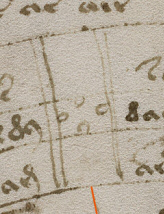 |
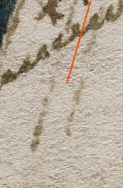 |
|
f67r, cropped, Voynich Manuscript, MS 408. Credit: Beinecke Rare Book and Manuscript Library, Yale University. Line overlay by P. Han
showing main marker. |
|
|
f67r,
cropped, Voynich Manuscript, MS 408. Credit: Beinecke Rare Book and Manuscript Library, Yale University. Line overlay by P. Han
showing main marker. |
|
|
c |
d |
|
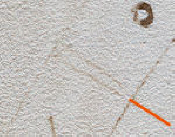 |
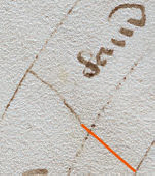 |
|
f57v, cropped, Voynich Manuscript, MS 408. Credit: Beinecke Rare Book and Manuscript Library, Yale University. Line overlay by P. Han
showing main marker. |
|
f57v, cropped, Voynich Manuscript, MS 408. Credit: Beinecke Rare Book and Manuscript Library, Yale University. Line overlay by P. Han
showing lesser marker. |
|
I propose eye direction indicates events
or direction also.
|
e |
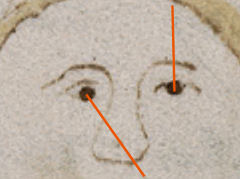 |
|
f58r, cropped, Voynich Manuscript, MS 408. Credit: Beinecke Rare Book and Manuscript Library, Yale University. Line overlay by P. Han
showing eye markers. |
I
propose human figures can indicate direction; by the way they face, point or
indicate.
|
f |
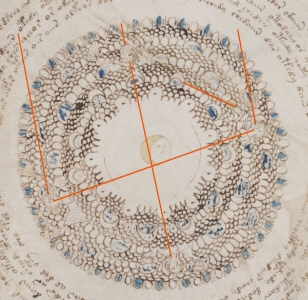 |
|
f85v, cropped, Voynich Manuscript, MS 408. Credit: Beinecke Rare Book and Manuscript Library, Yale University. Line overlay by P. Han
showing figure markers. |
The example on figure f. shows people indicating cardinal
directions and direction of view i.e. all looking in one direction. Note
the finger
also pointing which is found on other images as well. The image (g) below
shows an example of different types of markers on the page put together.
|
g |
|
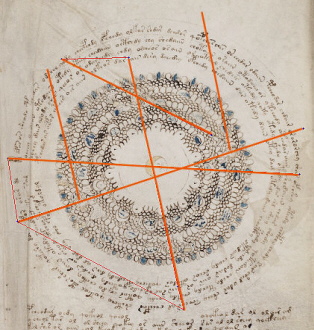 |
|
f85v, cropped, Voynich Manuscript, MS 408. Credit: Beinecke Rare Book and Manuscript Library, Yale University. Line overlay by P. Han
showing various markers. |
Some markers
appear to divide the image into sections
|
h |
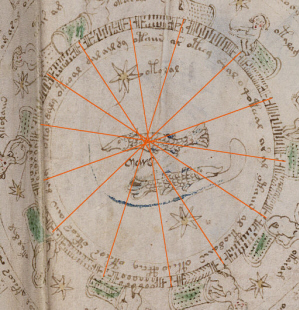 |
|
f70r, cropped, Voynich Manuscript, MS 408. Credit: Beinecke Rare Book and Manuscript Library, Yale University. Line overlay by P. Han
showing division markers. |
The rosettes page is a very complicated
example and whether it should be considered that each marker would apply to its
own rosette only or goes across the whole image to form what almost looks like a
nautical map is unknown. The markers are often not precisely drawn and lines
extended from them may be slightly varied depending how they are lined up.
|
i |
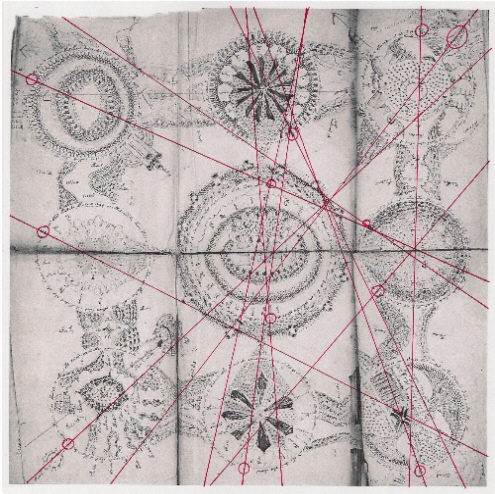 |
|
f86v, Voynich Manuscript, MS 408. Credit: Beinecke Rare Book and Manuscript Library, Yale University. Line overlay by P. Han
showing markers (position of actual markers indicated by circles). |
In conclusion, I propose that
although the images themselves give an “indication” of what is going on the
markers hold the key to “accurately” reading the information within the images
by indicating a network of lines that hold this information. I show examples of
using the markers this way within my own theory but others may find this way of
reading the markers fits other theories better.

Copyright © 2010 P. Han








